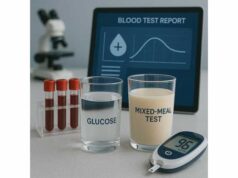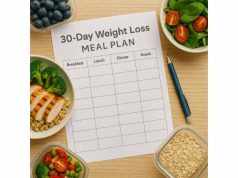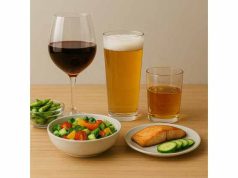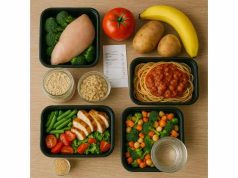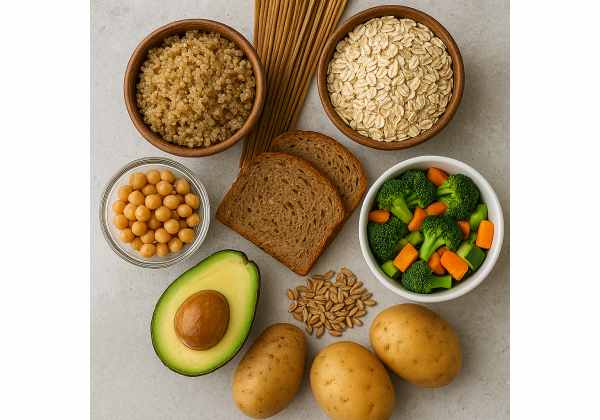
Carbohydrates do more than fuel workouts. The right amount and type can make a calorie deficit easier to maintain and help you stay consistent for months. When carbs are too low, energy and training quality dip; when they are mostly refined, hunger creeps back and portions drift larger. This guide shows you how to set a daily carb target that fits your calories, activity, and preferences, then choose satisfying, fiber-rich sources that keep you full. If you want the broader context on calories, protein, and fat before dialing in carbs, skim our primer on weight loss nutrition fundamentals. When you are ready, use the steps and food lists below to map an intake that works on busy weekdays and training days alike.
Table of Contents
- Carbs for weight loss: what matters
- How many carbs per day
- Best carb sources for fat loss
- Carb timing and workouts
- Portions, labels, and tracking
- Low carb versus low fat
- Troubleshooting plateaus with carbs
- Frequently Asked Questions
Carbs for weight loss: what matters
“Cut carbs” is catchy, but it is not a plan. Weight loss depends on a reliable calorie deficit, enough protein to protect lean mass, plenty of fiber for fullness, and a routine you can repeat. Carbs sit at the center because they influence appetite, energy, and performance—yet your best intake is individual. It depends on total calories, daily movement, training type, digestion, and food preferences.
Think in three levers: quality, quantity, and context.
- Quality means carbs that bring fiber and water: beans, lentils, whole grains, potatoes with skin, fruit, and vegetables. These foods deliver volume per calorie, so the plate looks generous and feels satisfying.
- Quantity is your daily grams. When protein and fat are set, the rest of your calories fall to carbs. The “right” number is one you can keep while feeling alert and in control of cravings.
- Context refers to timing. Many people do well clustering more carbs around training and keeping evening meals slightly higher in protein and vegetables on sedentary days.
Why quality changes the experience
Fiber slows digestion and steadies blood glucose, which reduces rebound hunger. Intact foods (oats, barley, potatoes, fruit) also hold more water, creating stretch in the stomach that helps your brain register fullness. For the same calories, a cup of lentils or barley usually beats crackers for staying power.
Why quantity is flexible
Plenty of people lose fat on moderate or even higher-carb intakes if protein is adequate and calories are controlled. Others eat more comfortably with a lower-carb pattern that leans on vegetables, legumes, and lean proteins. Both are valid. You do not need a universal number; you need a range that supports your life.
Set expectations and watch trends
Change carb intake and the scale can shift quickly at first because glycogen stores bind water. Look at 3–4 week trends with waist or clothing fit, not single days. If you want a safety-first roadmap before adjusting macros, our concise weight loss guide explains pacing, realistic rates of loss, and how to avoid common pitfalls.
Key takeaways
- Prioritize minimally processed carbs with fiber and water.
- Set protein first, then assign carbs and fats to suit appetite and activity.
- Use timing strategically, not rigidly.
- Judge progress by multi-week averages and how you feel, not daily swings.
How many carbs per day
There are three practical ways to set a carb target. Choose the method that matches how you prefer to plan meals.
Method 1: Percent of calories (simple and popular)
Pick protein first, choose a moderate fat range, then allocate remaining calories to carbs.
- Protein: roughly 30–35% of calories (or 1.6–2.2 g/kg body weight).
- Fat: about 20–30% of calories to cover essential needs and flavor.
- Carbs: whatever remains—often 35–50% of calories.
Example: On 1,800 calories, 30% protein (135 g) and 25% fat (50 g) leave 45% carbs (~203 g). This is a moderate-carb setup that fits most mixed-training weeks. If you want help balancing macros by body size and activity, see our guide to smart macro ratios.
Method 2: Grams per kilogram (great for training)
Base carbs on body size and workload.
- Sedentary to lightly active: 2–3 g/kg per day
- Regular mixed training (3–5 days/week): 3–5 g/kg
- High-volume endurance or sport blocks: 5–7 g/kg (consider a smaller deficit in heavy phases)
Example: A 75-kg person who lifts and does cardio 4 days per week might start at 3–4 g/kg (225–300 g), then adjust for hunger, energy, and weekly averages.
Method 3: Plate method (low-tracking)
Use visual portions if you dislike logging:
- Fill ½ the plate with non-starchy vegetables.
- Fill ¼ with lean protein (25–40 g).
- Fill ¼ with high-fiber carbs (beans, lentils, whole grains, or potatoes with skin).
- Add 1–2 teaspoons oil or nuts for flavor.
Most dinners land near 40–70 g carbs, depending on the choices, and naturally keep calories in check.
Protein first, then carbs
Protein steadies appetite and protects lean mass. Aim for 25–40 g per meal plus a protein-forward snack. After setting protein, decide how many calories to devote to fats; the remainder becomes your daily carbs. The most effective number is the one you can sustain while sleeping well and training consistently.
Adjusting over time
- If training feels sluggish, add 20–40 g carbs on workout days.
- If evenings feel snacky, shift more carbs to dinner from earlier meals.
- If fat loss stalls after 3–4 consistent weeks, trim 20–30 g carbs and/or 5–10 g fat (about 100–150 calories total) and reassess.
For a quick refresher on safe pacing and expectations while you test numbers, browse our weight loss guide.
Best carb sources for fat loss
The best carbs deliver fiber, water, intact structure, and micronutrients. They help you feel full on fewer calories and support recovery without driving cravings.
Legumes
- Examples: lentils, chickpeas, black beans, kidney beans, edamame.
- Why they work: fiber (7–15 g per cup), plant protein (10–18 g per cup), minerals like iron, magnesium, and potassium.
- How to use fast: stir into jarred marinara for a five-minute bolognese, fold into salads, blend into a creamy bean dip, or simmer with tomatoes and spices for a simple stew.
Intact or minimally processed grains
- Examples: oats, barley, farro, bulgur, quinoa, brown or wild rice.
- Why they work: steadier energy and more fiber than refined grains; chewy texture that slows eating.
- How to use fast: cook once on Sunday, portion into containers, and reheat with broth, lemon, and herbs.
Starchy vegetables
- Examples: potatoes (with skin), sweet potatoes, winter squash, corn.
- Why they work: high satiety per calorie; potatoes often outperform many foods for fullness.
- How to use fast: microwave a scrubbed potato for 6–8 minutes, air-fry wedges, or mash with Greek yogurt and chives.
Fruit
- Examples: berries, apples, pears, citrus, bananas, stone fruit.
- Why they work: portable portions and water-rich fiber that tame dessert cravings.
- How to use fast: pair with yogurt or cottage cheese, dice into salsas and salads, or make a simple compote for oatmeal.
Dairy and fermented dairy (if tolerated)
- Examples: milk, plain yogurt, kefir.
- Why they work: carbohydrate from lactose plus protein and calcium; strained yogurt is especially protein-dense.
High-fiber pastas and breads
- Examples: legume-based pasta, high-fiber whole-grain breads and tortillas.
- Why they work: convenient upgrades that add fiber and protein with familiar taste and texture.
Smart swaps that preserve satisfaction
- Swap 1 cup white rice → ¾ cup barley or farro for more fiber and chew.
- Swap fries → air-fried potatoes with skin for a bigger portion and more potassium.
- Swap 2 tablespoons peanut butter in a smoothie → 1 teaspoon peanut butter plus 1 tablespoon chia for similar flavor, more fiber, and fewer calories.
Approximate portions
- 1 cup cooked lentils: ~40 g carbs, 16 g fiber, 18 g protein
- 1 medium potato with skin: ~37 g carbs, 4 g fiber
- ¾ cup cooked barley: ~35 g carbs, 6 g fiber
- 1 cup cooked oats: ~27 g carbs, 4 g fiber
- 1 cup berries: ~15 g carbs, 3–8 g fiber
To raise fiber across the day with minimal effort, see our practical guide to daily fiber targets and easy swaps.
Carb timing and workouts
You do not need perfect timing to lose weight, but small adjustments around training can improve performance and adherence.
Before workouts
- Two to three hours prior: a balanced meal with 30–70 g carbs and 25–40 g protein works well. Examples: yogurt bowl with oats and fruit; chicken, rice, and vegetables.
- About one hour prior: 15–40 g fast-digesting carbs, low fat, modest protein. Examples: banana and yogurt; toast with cottage cheese; a small granola bar and a glass of milk.
- Early morning sessions: if you prefer to train fasted, keep intensity moderate, then eat a protein-rich meal afterward. If performance suffers, add a small pre-workout carb like a banana.
After workouts
- Aim for 20–40 g protein within a few hours to support repair.
- Add 30–60 g carbs to replenish glycogen and curb later cravings. Whole-food carbs (potatoes, rice, beans, fruit) work well.
Evening training
- It is fine to place more carbs at dinner after hard sessions. Many people sleep better that way. Keep the plate balanced and avoid very heavy, high-fat dishes late.
Rest days versus training days
- Keep protein constant. Flex carbs with activity: training days near 40–50% of calories from carbs, rest days near 30–40%, filling the gap with vegetables and a touch more fat for flavor.
Signs timing is helping
- You finish sessions strong, post-workout hunger feels manageable, and evening snacking declines. If energy drags or you overeat at night after training, shift 20–40 g carbs to the meal before or after the workout and reassess.
If breakfast is your weak link on training mornings, these protein-rich breakfast ideas make it easy to hit your targets without slowing you down.
Portions, labels, and tracking
Counting every gram is not required, but consistent portions are. Use these tools to keep estimates tight without turning meals into math homework.
Label literacy in one minute
- Serving size vs. your portion: if the label lists ⅔ cup and you eat 1 cup, scale the numbers.
- Total carbs vs. fiber vs. sugars: budget with total carbs; treat fiber as a bonus and aim for 25–38 g per day. “Added sugars” are the ones to limit during a deficit.
- Net carbs? Unless you follow a very low-carb plan, counting net carbs adds complexity without clear benefit. Most people do well tracking total carbs and prioritizing fiber.
Zero-math visual guides
- Plate method: ½ vegetables, ¼ lean protein, ¼ high-fiber carbs. Works at home and restaurants.
- Hand measures: a cupped hand of cooked grains (~30–40 g carbs); a fist of fruit (~15–25 g carbs); a thumb of oils or nut butter (~80–120 calories).
- Standard scoops: keep a ½-cup scoop in your rice and oats containers; measure occasionally to keep your “eyeball” honest.
Batch and balance
- Cook a pot of barley or rice, a sheet of potatoes, and a tray of protein on Sunday. Portions stay consistent all week.
- Keep two sauces ready (salsa verde and yogurt-tahini; chimichurri and lemon dressing). Flavor makes repetition sustainable without extra calories.
When to track closely
- If progress stalls for 3–4 weeks, log for 7–10 days with a focus on oils, nut butters, sweets, and drinks. Precision here often reveals hidden calories.
- If you eat out often, estimate conservatively and anchor the day with a protein-rich breakfast and a vegetable-heavy lunch.
For a fast visual refresher, our guide to the plate method shows simple ways to size carbs without a scale.
Low carb versus low fat
Both approaches can work when calories and protein are in line. The better plan is the one you can follow while feeling energized and satisfied.
When lower carb may fit your life
- You prefer savory, protein-forward meals with lots of vegetables.
- You feel steadier appetite with fewer refined grains and sweets.
- You are comfortable building meals around legumes, leafy vegetables, lean meats, fish, tofu, eggs, nuts, and modest portions of starchy foods.
When moderate or higher carb may fit your life
- You do endurance or high-volume training.
- You enjoy grains, beans, potatoes, and fruit and feel deprived without them.
- Sleep and digestion improve when dinner includes a reasonable portion of carbs.
What most evidence converges on
- Early differences between low-carb and low-fat diets mainly reflect water changes and novelty. Over months, adherence and sufficient protein predict success better than macro ratios.
- High-fiber carbs support fullness and micronutrient intake regardless of macro split.
- Extreme restriction often backfires; small, sustainable changes preserve willpower and social life.
A practical compromise
- Set protein first.
- Choose a carb range that supports your training and appetite.
- Keep fats mostly from whole foods and measured oils.
- Review weekly averages for weight and waist, not single days.
- Curious which split fits best? Test a modest lower-carb month and a modest higher-carb month—keeping calories and protein equal—and compare your energy and adherence.
For a balanced side-by-side view of each approach, see our overview of low carb versus low fat strategies.
Troubleshooting plateaus with carbs
If progress slows, resist drastic cuts. Troubleshoot with small, targeted changes for 10–14 days at a time and measure trends.
Common carb-related stalls and fixes
- Lots of “healthy” carbs, little protein. Oats, fruit, and grain bowls can still undershoot protein.
- Fix: Bring dinners to 25–40 g protein and 8–15 g fiber. Add beans to pasta, yogurt to bowls, or tofu to stir-fries.
- Too few carbs for your training. Under-fueling drives evening cravings and restless sleep.
- Fix: Add 20–40 g carbs around workouts and evaluate energy and late-night snacking.
- Refined carbs dominate. White breads, pastries, chips, and sugary drinks move fast and encourage more nibbling.
- Fix: Swap in legumes, intact grains, potatoes with skin, and fruit. Keep sweets as planned treats, not daily habits.
- Liquid calories. Coffee drinks, juices, and heavy smoothies can add 150–400 calories with little fullness.
- Fix: Audit beverages. Choose water, sparkling water, unsweetened tea, or simpler smoothies (fruit plus yogurt or protein plus leafy greens).
- Weekend swings. One large dinner and drinks can erase a week’s modest deficit.
- Fix: Bookend weekend days with a protein-rich breakfast and a vegetable-heavy lunch; set a drink plan and share sides.
When to change the numbers
If your weight trend or waist has not budged after 3–4 consistent weeks, reduce daily carbs by 20–30 g and fats by 5–10 g (about 100–150 calories total), or add a 20–30 minute post-meal walk. Reassess after two weeks.
If you want full-week menus that map high-fiber carbs to simple dinners, our 7-day high-protein plan shows how to implement this without complicated recipes.
Frequently Asked Questions
How many carbs per day should I eat to lose weight?
Most adults do well between 2–4 g/kg body weight per day or 35–50 percent of calories, assuming protein is high and fats are moderate. Start in the middle of that range and adjust by 20–40 g based on hunger, energy, and weekly progress.
Should I count net carbs or total carbs?
For weight loss, total carbs are simplest and accurate enough. Prioritize foods with fiber and aim for 25–38 g per day. Counting net carbs is optional and mainly helpful if you follow a very low-carb plan.
Are carbs at night bad for fat loss?
No. What matters most is daily calories and meal quality. Many people sleep better with a modest portion of high-fiber carbs at dinner, especially after training. Keep portions reasonable and pair with protein and vegetables.
Do I need keto to lose weight?
No. Keto can work, but so can moderate-carb diets with enough protein and fiber. Choose an approach that fits your preferences and lifestyle; adherence over months beats any single macro target.
How should I change carbs on rest days?
Keep protein constant and reduce carbs slightly—often by 20–40 g—replacing them with more vegetables and a bit of healthy fat for flavor. On hard training days, add those carbs back around workouts.
What are the best carbs if I get hungry easily?
Emphasize legumes, intact whole grains, potatoes with skin, fruit, and vegetables. These bring fiber and water that increase fullness per calorie. Pair them with 25–40 g protein at meals to steady appetite.
References
- Carbohydrates and Endurance Exercise: A Narrative Review of a Food First Approach 2023
- Athletes’ nutritional demands: a narrative review of nutritional requirements 2024
- Effects of low-carbohydrate diets versus low-fat diets on metabolic risk factors in overweight and obese adults: A meta-analysis of randomized controlled trials 2022 (Systematic Review)
- Cereal Fibers and Satiety: A Systematic Review 2025 (Systematic Review)
- 7 Dietary, Functional, and Total Fiber | Dietary Reference Intakes for Energy, Carbohydrate, Fiber, Fat, Fatty Acids, Cholesterol, Protein, and Amino Acids 2005 (Guideline)
Disclaimer
This guide provides general education and is not a substitute for personalized medical advice, diagnosis, or treatment. Consult your healthcare professional—especially if you have diabetes or use glucose-lowering medication, are pregnant or breastfeeding, or have a history of disordered eating—before making significant changes to your diet.
If this article was useful, consider sharing it with someone planning their meals, and follow us on Facebook, X, or whichever network you use for practical nutrition tips and calm, evidence-based guidance each week.

